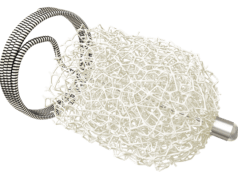 From parallel grafting to the role of hybrid operating rooms, the importance of vascular surgeons having a wide range of devices and options at their disposal was highlighted throughout yesterday’s CX Aortic Vienna juxtarenal sessions. As Roger Greenhalgh (London, UK) noted towards the end of the day’s programme, operators should take advantage of all the latest open and endovascular techniques—many of which were not available even five years ago.
From parallel grafting to the role of hybrid operating rooms, the importance of vascular surgeons having a wide range of devices and options at their disposal was highlighted throughout yesterday’s CX Aortic Vienna juxtarenal sessions. As Roger Greenhalgh (London, UK) noted towards the end of the day’s programme, operators should take advantage of all the latest open and endovascular techniques—many of which were not available even five years ago.
One presentation that highlighted this distinctly was delivered via an edited case by Benedikt Reutersberg (Zürich, Switzerland), who reported the treatment of an 80-year-old male patient with a type 1a endoleak via fourfold fenestrated endovascular aortic aneurysm repair (FEVAR). The presenter noted that this was “a very complex operation” that took eight hours but ultimately showed successful perfusion on the final angiogram—and the patient was doing “very well” at five-month follow-up.
FEVAR following failed chimney endovascular aneurysm repair (ChEVAR) is technically feasible, but challenging, and requires the “whole armamentarium of vascular surgery”, Reutersberg stated. He added that, ideally, such procedures should be performed in a hybrid operating room where operators can shift back and forth between open and endovascular techniques, before concluding that—in order to reduce the chances of complicating secondary interventions after failed ChEVAR— ChEVAR should only be considered as a bailout strategy in initial procedures.
On day one, Joost van Herwaarden (Utrecht, The Netherlands) and Gustavo Oderich (Houston, USA) also presented edited cases demonstrating FEVAR with a custom-made stent graft in narrow iliac access vessels, and how to troubleshoot fenestrated/branched (F/BEVAR) after prior PETTICOAT repair, respectively.
Achieving greater ChEVAR standardisation
Stefano Fazzini (Rome, Italy) presented his view of a “new era” in ChEVAR by outlining the PROTAGORAS 2.0 study. This study set out to introduce a new set of rules and improve standardisation in ChEVAR—addressing prior concerns surrounding inadequate planning and sizing. Fazzini deemed a specific stent graft system plus a balloon-expandable covered stent (BECS) the “ideal combination” for ChEVAR procedures, and oversizing between 30% and 40% as well as a total neck length >20mm are among the key planning points derived from PROTAGORAS 2.0.
Endosuture aneurysm repair reduces complications for wide neck patients
Apostolos Tassiopoulous (Centereach, USA) presented the three-year wide neck outcomes from the ANCHOR study, which he described as “excellent”, despite wide necks typically being “associated with more complications”. The prospective, multicentre, real-world database comprises data on patients receiving endosuture aneurysm repair (ESAR) for aortic aneurysm with a specific endoanchor device.
Of the 1,032 patients included in the database, there were 771 in the primary arm, of whom 72 were wide neck patients. At three years, Tassiopoulous shared that the wide neck group was 100% free from rupture, migration and reintervention for type 1a endoleaks.
The presenter’s conclusion was that, while “literature demonstrates that patients with wide necks are at greater risk for type 1a endoleaks, rupture, secondary procedures and mortality”, the outcomes at three years for wide neck patients are “comparable to [those of] standard endovascular aneurysm repair [EVAR] in favourable anatomy” and thus “positive”. During the subsequent discussion, which encompassed approaches for short and tapered neck patients, Tassiopoulous noted the importance of appropriate sizing and position of the endograft, especially in the case of a tapered neck.
New technique for juxtrarenal aortic treatment
Narrow iliac access, downward-facing side branches and aortic angulations form the mainstay of challenging anatomies for current fenestrated platforms, said Vincent Riambau (Barcelona, Spain) who reported early experience of a new FEVAR platform in combination with a new covered balloon-expandable stent.
Since September last year, the team at his centre in Barcelona has embarked on gathering data on this new approach and reported an uneventful emerging experience of eight cases with 31 fenestrations.
Elaborating on the strengths of the two devices used in the new technique, Riambau told delegates, “[the new FEVAR platform] allows cannulation from above, while the proximal clamping remains closed.” Additionally, the low-profile device (19Fr outer diameter) with concentric reducing ties benefits from lock stent technology and enables operators to permanently cannulate the contralateral leg and supports proximal dual fixation, he elaborated. Furthermore, the covered balloon-expandable stent benefits from being highly flexible and resistant to kinking, from radiopaque markers and by not shortening. The balloon also inflates and deflates quickly, he advised.
Responding to a question from Viji Thomson (Vellore, India) on whether the covered balloon-expandable stent needed to be relined with self-expanding stents, Riambau revealed that this was not necessary.
Case highlights cone-beam CT as key in F/BEVAR
Next on the agenda was Andres Schanzer (Worcester, USA) who described the use of branched/fenestrated technology to repair an aortic pseudoaneurysm in a 78-year-old woman who developed a pseudoaneurysm 20 years after a previous aorto-aortic bypass for midaortic syndrome. “At age 53, the patient was treated for aortic coarctation with descending to infrarenal aortic bypass and bypass to bilateral renal arteries,” Schanzer said. Following that early procedure, there was a thrombosis of the right renal bypass necessitating a further bypass, but the patient recovered well after prolonged hospitalisation, he added.
The patient was referred for the aortic pseudoaneurysm that developed, which then progressively dilated to 6.1cm. It was at this threshold that Schanzer and team decided to intervene.
“Our treatment plan consisted of using a branched endograft with two branches going down for the coeliac and small mesenteric artery made into a fenestrated endograft in the aortic-aortic bypass with a fenestration for the left renal artery,” detailed Schanzer. His presentation of what was described as “an unusual and interesting case” saw the audience taken stepwise through the techniques used.
The patient was extubated in the operating room, was ambulating the day after and discharged two days after the procedure. “The computed tomography [CT] angiogram at one month demonstrates complete pseudoaneurysm exclusion, all branches patent and no endoleaks,” reported Schanzer.
The panel commented on the importance of excluding infection at the outset of this case, which was described as “critically important”, and active discussion on the spinal cord ischaemia prevention protocol. Schanzer then introduced a randomised controlled trial currently underway examining a prophylactic versus therapeutic spinal drainage approach. Further points raised included antiplatelet regimen and the importance of cone-beam CT for any fenestrated and branched cases, particularly to assess stent architecture. There was wide panel agreement that this technological advancement does help prevent unnecessary reinterventions.












